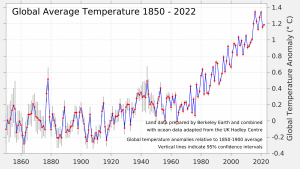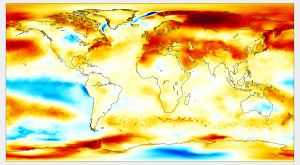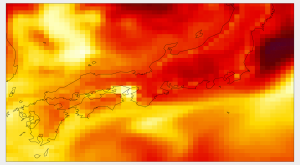Berkeley Earth provides high-resolution land and ocean time series data and gridded temperature data. Our peer-reviewed methodology incorporates more temperature observations than other available products, and often has better coverage. Global datasets begin in 1850, with some land-only areas reported back to 1750. The newest generation of our products are augmented by machine learning techniques to improve the spatial resolution. This allows Berkeley Earth to provide the most comprehensive, high-resolution instrumental temperature data product available.
Below we have made our data accessible at the global, national/regional, and local levels. Source and intermediate data is available as well. For technical questions or inquiries about the data, please contact data@berkeleyearth.org.
Licensing
In general, Berkeley Earth’s data is licensed under Creative Commons BY-NC 4.0 International for non-commercial use only. Accessing the data provided on this page constitutes agreement with these terms. Attribution under CC BY-NC terms should be given to Berkeley Earth, including reference to www.berkeleyearth.org when possible.
For licensing in commercial applications, please contact admin@berkeleyearth.org.
Free or low cost access is also available for academics and journalists. For academic publications and other permissions requests please contact permissions@berkeleyearth.org.
Global Temperature Data
Global Monthly Averages (1850 – Recent)
Berkeley Earth combines our land data with a modified version of the HadSST ocean temperature data set. The result is a global average temperature data set.
Global Land Only (1750 – Recent)
Berkeley Earth’s primary product is an analysis of summary air temperatures over land. The following files and links provide time series that summarize those results for the global average.
- All Global Land:
Global Daily Land (Experimental; 1880 – Recent)
This data set is an experimental temperature time series with daily resolution.
Datasets are also provided in a gridded NetCDF format. Two types of grids are provided, a grid based on dividing the Earth into 15984 equal-area grid cells and a latitude-longitude grid. The equal area grid is the primary data format used in most of our analyses and provides generally smaller files; however, that format may be less convenient for many users.
Datasets marked as “Experimental” below are products that are under development have not peer reviewed, and are included here so that potential users can give us feedback.
- Global Monthly Land + Ocean
- Average Temperature with Air Temperatures at Sea Ice (Recommended; 1850 – Recent)
- Video of Temperature Field
- Equal Area (~100 MB)
- 1º x 1º Latitude-Longitude Grid (~400 MB)
- Average Temperature with Water Temperatures at Sea Ice (1850 – Recent)
- Equal Area (~100 MB)
- 1º x 1º Latitude-Longitude Grid (~400 MB)
- README
- Average Temperature with Air Temperatures at Sea Ice (Recommended; 1850 – Recent)
- Global Monthly Land
- Average Temperature (TAVG; 1753 – Recent)
- Video of Temperature Field
- Equal Area (~45 MB)
- 1º x 1º Latitude-Longitude Grid (~200 MB)
- High Temperature (TMAX; 1833 – Recent)
- Equal Area (~35 MB)
- 1º x 1º Latitude-Longitude Grid (~140 MB)
- Low Temperature (TAVG; 1833 – Recent)
- Equal Area (~35 MB)
- 1º x 1º Latitude-Longitude Grid (~140 MB)
- README
- Average Temperature (TAVG; 1753 – Recent)
- Global Daily Land (Experimental; 1880 – Recent)
- Average Temperature (TAVG)
- Average High Temperature (TMAX)
- Average Low Temperature (TMIN)
- README
Berkeley Earth is preparing an updated high-resolution temperature data set. Some materials related to this update are being released as a beta version to allow for additional feedback before final publication. Results are preliminary and subject to change without notice.

High-Resolution Global Monthly Averages (Experimental; 1850 – Recent)
The global monthly averages derived from the high-resolution data set are available as a beta version here.
High-Resolution Global Land Only (Experimental; 1750 – Recent)
The global monthly land-only averages derived from the high-resolution data set are available as a beta version here.
Berkeley Earth has released a beta version of our new high-resolution monthly gridded mean temperature data product covering the whole Earth from 1850 to present with 0.25° x 0.25° resolution.
This beta version update is being released to allow for additional feedback before final publication. Results are preliminary and subject to change without notice.
These files are, by necessity, very large. Lower-resolution data sets derived directly from the whole are also available below to aid users who do not require the full resolution.
For access to the full high-resolution data product, please complete this form. For technical questions related to this or other data products, please contact data@berkeleyearth.org.
- High-Resolution Global Monthly Average Temperature (Experimental; 1850-Recent)
- Full 0.25° x 0.25° Resolution (available upon request)
- 1° x 1° Resolution Field (~400 MB)
- 5° x 5° Resolution Field (~8 MB)
- Description file for this data
Regional, national and city-level subsets are also available below.
National and Regional Temperature Data
The following links provide access to regional summaries for our existing Berkeley Earth data set.
- Regional Summaries:
- National Summaries:
The new high-resolution Berkeley Earth data set has been used to construct new country, regional and local summaries. This beta version is being produced to allow for additional feedback before final publication. Results are preliminary and subject to change without notice.
Available Data:
- All countries monthly mean temperature time series and annual summaries (by request)
- State / Province level monthly and annual mean temperature times series for selected countries (by request)
Example files:
For technical questions related to this or other data products, please contact data@berkeleyearth.org.
Berkeley Earth has released a beta version of our new high-resolution monthly gridded mean temperature data product covering the whole Earth from 1850 to present with 0.25° x 0.25° resolution.
This beta version update is being released to allow for additional feedback before final publication. Results are preliminary and subject to change without notice.
These files are, by necessity, very large. Lower-resolution data sets derived directly from the whole are also available to aid users who do not require the full resolution.
For access to the full high-resolution data product, please complete this form. For technical questions related to this or other data products, please contact data@berkeleyearth.org.
Preselected regional subsets are available from the gridded data products, including:
- 0.25° x 0.25° Gridded Monthly Average Temperature (1850-Recent; by request)
- North America (920 MB)
- Contiguous USA (181 MB)
- South America (350 MB)
- Africa (530 MB)
- Europe (226 MB)
- Asia (1.2 GB)
- Australasia (510 MB)
- Antarctica (560 MB)
- Description file for this data
- North America (920 MB)
- 1° x 1° Gridded Monthly Average Temperature (1850-Recent)
- North America (59 MB)
- Contiguous USA (12 MB)
- South America (22 MB)
- Africa (33 MB)
- Europe (15 MB)
- Asia (77 MB)
- South Asia (29 MB)
- Australasia (32 MB)
- Antarctica (35 MB, 1950-Recent)
- Description file for this data
- North America (59 MB)
Local & Individual Station Data
From the current (lower-resolution) version of the Berkeley Earth data set, we provide rough city-level estimates at ~110 km resolution with monthly average low, high and mean temperature For improved data see the next section.
- Local Time Series Data
The new high-resolution dataset, augmented with machine learning technology, does a much better job reconstructing climate change histories at the level of individual urban areas. The target resolution is ~25 km. Available periods vary, with most cities starting from roughly 1850-1900. A few cities start as early as 1750.
- Monthly and annual average time series are available for ~8,000 cities, by request
Samples:
For technical questions related to this or other data products, please contact data@berkeleyearth.org.
Breakpoint Adjusted Monthly Station data
During the Berkeley Earth averaging process we compare each station to other stations in its local neighborhood, which allows us to identify discontinuities and other heterogeneities in the time series from individual weather stations. The averaging process is then designed to automatically compensate for various biases that appear to be present. After the average field is constructed, it is possible to create a set of estimated bias corrections that suggest what the weather station might have reported had apparent biasing events not occurred. This breakpoint-adjusted data set provides a collection of adjusted, homogeneous station data that is recommended for users who want to avoid heterogeneities in station temperature data.
- Individual Station Data
- Complete Station Archives:
Diagnostics
Source data consists of the raw temperature reports that form the foundation of our averaging system. Source observations are provided as originally reported and will contain many quality control and redundancy issues. Intermediate data is constructed from the source data by merging redundant records, identifying a variety of quality control problems, and creating monthly averages from daily reports when necessary. The definitive repository for Source and Intermediate data is located in the SVN, which is built nightly.
The source files we used to create the Berkeley Earth database are available in a common format.
Multi-valued
This includes all time series from the originating datasets. Due to duplication with the same data being reported by multiple agencies, on average there will be 3-4 time series reports with each site. Only limited quality control flagging has been performed at this stage.
Single Valued
Data have been collapsed so that there is only one time series per location. Quality control procedures have been completed and their output is reported via a series of quality “flags”. Users of this data set will have to consider these flags and remove any data they don’t want to use. Seasonality is preserved in this data set.
Quality Controlled
Same as “Single-valued” except that all values flagged as bad via the quality control processes have been removed. This dataset is recommended for users that require relatively clean data. However, no adjustments have been made for heterogeneous and other biasing events. Please consider the breakpoint adjusted station data above if you wish to avoid heterogeneity.
Berkeley Earth’s main analysis uses a variety of techniques to detect and compensate for systematic problems with the source data. For example, measurement discontinuities often occur when observing stations are moved or instrumentation is change. However, for diagnostic and pedagogical reasons it can be useful to look at averages when many of the quality control and homogenization features of the Berkeley Earth algorithm have been disabled.
These files are updated infrequently.
Global Raw Land Only Monthly (1750 – Recent)
The following files provide time series that summarize the raw data, omitting most of the bias and error detection steps.
- Raw Monthly Average Temperature (raw annual summary)
- Raw Monthly Average High Temperature (raw annual summary)
- Raw Monthly Average Low Temperature (raw annual summary)
Raw Land Only Monthly Gridded Fields (1750 – Recent)
The following files provide gridded land data that summarize the raw data, omitting most of the bias and error detection steps. The format is the same as the land data described above.
- Global Raw Monthly Land (Diagnostic)
- Average Temperature (TAVG; 1753 – Recent)
- Equal Area (~45 MB)
- 1º x 1º Latitude-Longitude Grid (~200 MB)
- High Temperature (TMAX; 1833 – Recent)
- Equal Area (~35 MB)
- 1º x 1º Latitude-Longitude Grid (~140 MB)
- Low Temperature (TAVG; 1833 – Recent)
- Equal Area (~35 MB)
- 1º x 1º Latitude-Longitude Grid (~140 MB)
- Average Temperature (TAVG; 1753 – Recent)
- Contiguous United States Average Temperature (TAVG; 1850 – Recent)
- Europe Average Temperature (TAVG; 1850 – Recent)



